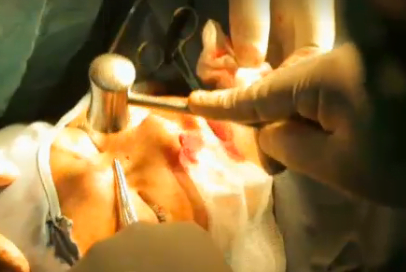Liane Gutcher, Leslie Knott and Clementine Malpas, are some of my favorite film-makers who have worked in Afghanistan. Previously, Knott and Malpas had created In-Justice, a film about women imprisoned for moral crimes in Afghanistan. Their new documentary, Nip, Tuck Kabul, aired on the UK’s Channel 4, discusses the emerging prevalence of cosmetic surgery in Afghanistan.
The documentary shows increasing number of women and men going under the knife for tummy tucks and nose jobs, despite the high cost of surgery and the wide-spread poverty in the country. The story of a young woman, Shaheda, who has saved several months’ salary to get her nose enlarged, is highlighted in the story. Shaheda is glorified as her decision to change her “flat nose” is portrayed as an example of personal freedom. The case of Mrs. Zalmay who is being pressured by her husband to get a nose job is another narrative brought to light, but the film does not go into details about how and why she is pressured and argues that the couple has “disagreements” about whose idea the surgery was. The film also discusses the possibility of another young woman, a nurse named Shabnam, being addicted to plastic surgery after several operations.
The filmmakers are quick to call these cosmetic surgeries “freedom of choice.” Phrases like “promise of emancipation,” “new-found freedom” and “symbol of free choice” are used liberally to describe the operations. The women and men undergoing cosmetic surgery are commended for defying rules about how they must look, which the narrator argues have been created by religious leaders. The film ends with the thought that women like Shabnam and Shaheda represent the “new Afghanistan,” if there is such a thing.
Is This Freedom?
Medical ethics and standards of beauty are tied with cosmetic surgery everywhere in the world. Afghanistan is no exception. Cosmetic surgery in Afghanistan is tied to bigger questions of racial, ethnic and gender hierarchy and standards of beauty. Shaheda and Shabnam are both women from the Hazara ethnicity in Afghanistan. These two women receive facial surgery to “fix” her “flat” nose and lift her “baggy” eyes respectively. Both facial features are more common, though not exclusive, to Hazara people in Afghanistan. These women, in other words, are at the cosmetic surgery clinic to erase from their face, literally, their ethnic identity.
According to Nip, Tuck Kabul, men and women make the choice to disguise their ethnicity, and this should be celebrated as an act of personal freedom and rebellion because for too long religious leaders have determined how people should look. The underlying hypocrisy in the film is that it ignores that women and men are changing their faces because of other rules that exist in the society about their facial features, rules that are racially-based. It is not freedom of choice for racial minorities to change their looks to conform to the majorities’ standards of beauty. If it is wrong for religious leaders to make rules about appearance, it should be equally unacceptable for racial hierarchies to set standards of beauty.
The documentary, though it mentions that many are undergoing surgery to conceal their ethnicity, ignores the racial, ethnic and gender hierarchies of the business and continues to call these modifications “acts of freedom.” It overlooks that many of the customers are Hazara women who change their looks because of the inferiority assigned to their physical features by a culture that views big eyes and tall noses as superior and values women based only on their appearance.
By not questioning the motive of these surgeries, the documentary, like those receiving surgeries, assumes that in fact big noses are “better,” or “in-fashion,” as the anchor phrases it, and that “Hazara’s flat noses” must be “fixed” and “concealed” for being somehow “inferior or ugly.” Nip, Tuck Kabul perpetuates the racist standards of beauty that exist in the Afghan culture by calling these surgeries liberation and freedom of choice.
